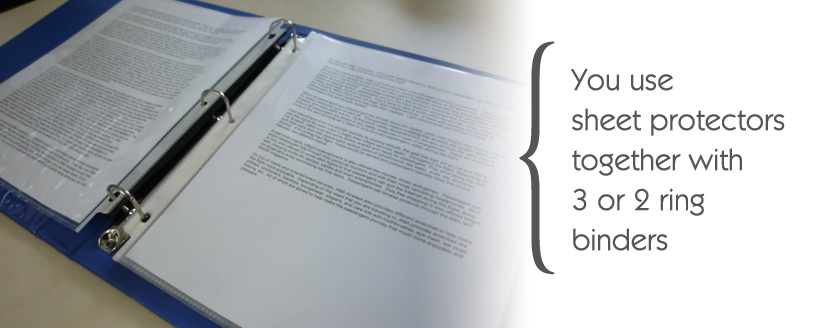Sheet Protectors 101
Sheet protectors are basically plastic pockets where you can store and protect papers from being damaged by things like water, tears, foods, spills, fingerprints, etc. It will also have an arrangement of holes punched on the side so that you can place them into ring binders for organizing. This is great because you no longer have to punch holes in to your paper. Together with binders, you can make presentations, menus, reference guides, portfolios, etc.
There are two important characteristics for sheet protectors: 1. it’s ability to protect your documents, and 2. it’s ability to let you organize your documents easier. These two characteristics work together to give users the opportunity for a much easier and convenient method for archiving, presenting, and organizing. So how do sheet protectors do that? Well there are several factors that gives sheet protectors the aforementioned characteristics: material types, and its thickness and finish, and also archival safety.
How to Use Them

Without going into the details of things like choosing the right material, the material thickness, and the finish of the sheet protector, it is actually quite simple to use them. First off you will need to know what size you are working with. There are lots of sizes of sheet protectors available for different paper sizes. Standards ones like letter size or legal size are everywhere, while odd sizes like 14x17 or 17x11 might be hard to find but are available somewhere online. After knowing what size you’re working with and having purchased them, the next thing is to find a binder to put them in. This is important because you want to have a binder that is made to store the specific size you’re using. You obviously don’t want a binder that is too small to fit your paper, and you also don’t want a binder that is too big because it will be too hard to handle. Some companies will offer matching binders to be used with their sheet protectors.
Another important thing to keep in mind is the holes punched on the sheet protector should match the rings that are on the binder otherwise you won’t be able to put them together. If you have sheet protectors that are punched for 2 ring binders then you need to get a 2 ring binder, and so on. However, most sheet protectors today are punched with multiple holes so that they can fit different ring binders.
Once you have sheet protectors and the right binder, you can now easily put them together as an organizing system for whatever you are storing or as a portfolio to showcase artworks and other items. Start with inserting your documents into the sheet protectors and then place the sheet protector into a fiting binder and you're set to go. Here's a good video showing how you can insert docuemts into sheet protectors an an easy and fast way.
Different Sizes
Other than your standard or typical letter size sheet protectors, there are other sheet protectors available for different sized documents - some sizes are easier to find, others not so easy. For example, you can easily find sheet protectors for letter size, legal size, and A4 paper. Sizes like 14x17, 11x17, or even landscape formats of letter size and legal size are harder to find. Here is a list of the sizes we know that you can find sheet protectors for:
|
|
|
|
